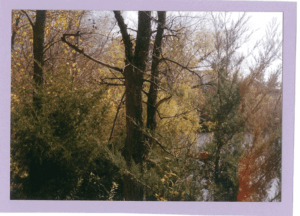
The picture on the opposite page is a copy of an original picture of the Verba Quarry in Mt. Vernon, Iowa taken prior to World War II. The Verba Quarry is located in the Southeast quadrant of Mt. Vernon (See highlighted below).

The picture below was recently taken from the same vantage point as the picture to the left.

Today, the Verba Quarry and the surrounding area form Nature Park, a city conservation and recreation area.


In the late 1800s Billy Conklin was cutting stone from a pit south of town to be used for constructing many of Mt. Vernon’s most prominent buildings. This quarry was under the management of William Platner of Ivanhoe. At that time the quarry was producing about twelve railroad cars of stone in a day.
Julian Verba was the owner of the quarry from about 1918 until the 1960s. In the 1940s the Cappy Gaines’ family leased the quarry from Julian Verba for ten cents a ton. They operated it for twenty years. During this time 4-10 employees worked the quarry.
Most of the work was hard manual labor. A one man stone weighed up to one-hundred pounds, a two man stone weighed up to two hundred pounds. The limestone was sold by the perch, a hundred square feet.
Equipment included a crusher, a hammermill, a channel saw run by steam and a stiff leg which had grabbers to pick up limestone over two hundred pounds. Robert Gaines, Cappy’s son, built the crushing plant.
The quarry is spring fed. The quarrymen dug a sump pit to collect the water. This water was then pumped into the creek to the east. At some times, the water was spread on the overburden to wash off the limestone.
The first major consumer of the limestone was the Chicago Northwestern Railroad. Limestone block was used for bridge abutments and culverts. Crushed rock was used on the railroad bed. They built a railroad from the quarry to the main railroad so they could transport the limestone to build the railroad. During World War II, the steel rails were removed for use in the war. The rail bed in Nature Park can still be seen on the north and east side of the quarry. The line split with a spur going down into the quarry and the second spur went to the crushing plant.
Lots of the limestone from the quarry was used as foundations for many houses in this area. At least one house in Mt. Vernon is made entirely of stone from the Verba quarry. In the thirties, the Civilian Conservation Workers (CCW) used the limestone to construct buildings in Palisades Park and at Lake McBride State Park.
There are several actual quarries in this area. An area in the northwest part of Nature Park was a quarry, which later served as a city dump. Prior to the present alignment of highway 30, the quarry extended to a point south of the highway. This area was also a city dump for a number of years. Much of this area was filled in for construction of the highway. At this time, the Gaines began quarrying to the west. They quarried as close to the highway as they were allowed to go. The best rock was in this area. They stopped quarrying in the mid-sixties. Robert Gaines dammed the water at the southeast corner creating the pond in the park. The water in the quarry is approximately 5 feet deep except at the sump holes.

An early entry road into the quarry. This road was used by horse and wagon. A scalehouse sat on the left,

This was the last entrance into the quarry. Robert Gaines operated the quarry for 20 years.









The satellite picture is a picture taken in 1992 of the quarry. The part that I’ve highlighted was originally a quarry before they filled it in with a dump.

Most of the information that I’ve collected for this project was received from an interview with Bob Gaines. He actually went to the quarry with me and pointed out the various sites.
One interesting story that Bob Gaines told me about was finding horizontal petrified fir trees in the limestone. A sample of these trees was given to Cornell College who in turn sent the sample to Chicago for evaluation. It was determined that the trees were seven to eight million years old and had been placed in the limestone by a glacier.
The picture on the next page depicts some of the equipment used in the quarry. Bob Gaines and his father built all of this equipment.


